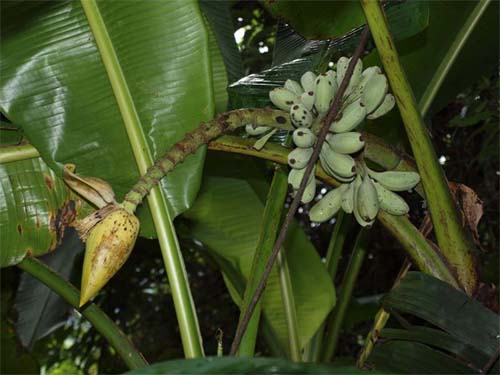Musa itinerans var. kavalanensis Information
Identification:
Plants freely stoloniferous, developing longrhizomes 15 cm or more from the parent plant, position vertical, up to 5 suckers; mature pseudostems 2.5 m tall or more, to 4 m, 28-44 cm diam. at base, green with varying development of red-brown pigmentation according to age and exposure; the pseudostem covered with varying amounts of dead brown leaf sheaths, the underlying colour light green with large red-brown blotches, shiny; sap watery. Leaf sheaths and petioles devoid of wax; leaf blades developing on the fourth, fully unfolded leaf basipetally from the plant apex, ca. 175-220 x 47-59 cm, bases obtusely rounded to oblique, entire, the apex obtuse, lateral venation pinnate and parallel, midrib usually prominent, blades often tearing between the lateral veins, yellowish green to green on both surfaces, glabrous; petioles 30-40 cm, usually green, caniculate with the canal wide, margins narrow, membranous and erect, not clasping the pseudostem. Inflorescence at first semi-erect to horizontal and then falling vertically downward; peduncle ca. 55-80 cm, robust, pale green to rusty brown, densely puberulent; sterile bracts 2, bracts deciduous at opening of the first flowers; basal flowers bisexual, the others male; spathe long-lingulate, 31.7 x 11.4 cm wide at centre, apex convolute, bracts yellowish green, revolute and lifting one at a time after flowering, with the subsequent 1 to 2 bracts acropetally revolute, lifting before the older bract is deciduous; bract scars prominent. Flowers 11 to 13 per bract, biseriate, ovary inferior, pale green, glabrous, ca. 4.6cm, markedly 5-angled, locules 3, ovules disposed in 4 rows; compound tepals ca. 4.8 cm, with 2 prominent thickened keels, ribbed at the dorsal angles, with 5-lobed, pale yellow apex, free tepals translucent white, ca. 3.2 cm, oblong-acuminate, smooth; stamens 5 with sterile pollen, ca. 5.2 cm, filaments white, anther pale yellow; style straight, ca. 4.1 cm, creamy white, stigma capitate, greyish black after pollination. Male buds lanceolate, 15.8 x 7.5 cm, pendulous, bracts yellowish green on both sides, convolute at the tip; bract lifting sequentially as 1 bract at a time, lifting and revolute, similar to those subtending the lower flowers; bract scars prominent. Male flowers 14 to 15 per bract, in 2 rows, falling with the bract, compound tepals usually 5-lobed, ca. 4.5 cm, pale yellow, central lobes smaller than the outer lobes; free tepals translucent white, ca. 2.2 cm, oblong-acuminate, stamens 5, filaments white, ca. 4.3 cm; fertile gynoecium 1 ,style straight, stigma cream, ca. 4.3 cm, ovary arched, pale green, glabrous, 1.1 cm. Fruits bunch nearly horizontally, compact, with 3 to 10 hands per bunch. Individual fruit usually negatively geotropic, ca. 6.7-8.5 x 2.5-2.8 cm in diam., ca. 21-38 g in weight, straight, slightly ridged, obscurely 5-angled at maturity, apically blunt with persistent floral remains; fruit pedicels 1.1-1.4 cm, pale green, minutely puberulent; immature pericarp whitish green, minutely puberulent, becoming pale green and splitting lengthways occasionally at maturity, dull yellow at full ripeness, not strongly aromatic, sweet and sour taste; seeds small, dark brown, warty, ca. 2.1 x 4.1-4.8 mm diam., irregularly angulate-depressed, 100 seeds with a weight of 2.9 g.
General Information:
The kavalanensis variety was only known from 2, small, roadside populations, where the original IUCN Red List category was to be cited as vulnerable or critically endangered, until the full distribution was mapped out, with over 100 new populations found on the hillside. (Markey et el. 2010.). The IUCN Red List category for this taxon is now of minimal conservation concern and should be considered Least Concern (LC). Musa itinerans var. kavalanensis and variety formosana were occasionally seen as growing sympatrically. However, no obvious hybrids were observed in those populations.
Distribution:
Native to, Taiwan
The known populations occur in mountainous areas at elevations from 220 to 820m, along the 202 logging track (Yingshih village) on gentle to very steep slopes and the roadside of Prov. 7 Highway (Nioudou village), Ilan County, which is located in northeastern Taiwan.
Location: Taiwan (24.636339°N, 121.526642°E)
Observations
Musa itinerans var. kavalanensis Overlay Image ©2025 Trebrown - No re-distribution without permission.

